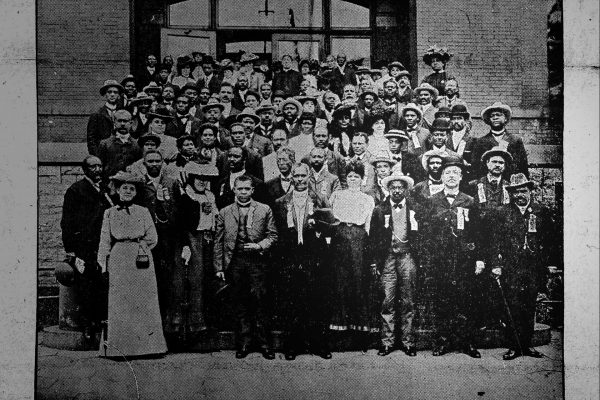In 1911 a congressional special committee convened to investigate the impact of new business practices on the lives of workers. Of particular interest to the committee was something called scientific management, a technique that sought to measure and improve worker productivity. The system’s most vocal proponent, a mechanical engineer named Frederick Winslow Taylor, had just published his magnum opus, The Principles of Scientific Management. Taylor’s work would become an inspirational touchstone for the management profession. Indeed, his influence continues today. Articles profiling management pioneers often begin with him, lauding his efforts to apply precise metrics to even basic processes.
The parallels between present-day business management practices and slavery have been persistently neglected in mainstream discussions about the history of U.S. enterprise.
However, when Taylor and others were called to testify in 1911, the tone was far from inspirational. And scientific management’s critics gestured to a very different point of reference—slavery. An experienced iron worker from the Watertown Arsenal in Massachusetts told the committee that scientific management felt to him “as if it is getting down to slavery.” Managers, he said, exerted extreme control, “following you when you are at your job . . . and with a stop watch stand over you while you bend down to pick up a few rods. . . . This is too much for a man to stand.” The head of a machinists’ union argued that the system had “reduced the men to virtual slavery, low wages,” and that it had “engendered such an air of suspicion among the men that each man regards every other man as a possible traitor or spy.” At the close of the hearings, though the committee took little action, it agreed that elements of the system acted “the same as a slave driver’s whip on the negro, as it keeps him in a constant state of agitation.”
Of course, the ticking of a stopwatch is wildly different from the lash of the whip—or a whip and a watch used in tandem, as was the case on some plantations. But there is nonetheless something revealing and deeply troubling about the analogy, particularly because proponents of scientific management sometimes used the language of slavery as well—and not to condemn the system but to praise it. One associate of Taylor’s, Scudder Klyce, argued that scientific management was simply a system of “Cooperation or democracy,” but Klyce’s definition of democracy was decidedly undemocratic: he describes it as a system that “consists of the able person’s taking the lead in giving ‘orders’ in the cases where he is of superior ability, and the others’ submitting: it is the relationship of master and slave, regardless of how otherwise it may be named.” From the manager’s perspective, control was the essential characteristic of scientific management. The relations of control could change over time: “At any time a lathe hand may be able to show the superintendent a better way.” But from the perspective of workers, fleeting reversals offered little benefit. When they showed the superintendent a better way, they gave up their own power. They rendered themselves replaceable.
The most striking parallel between slavery and scientific management can be found in the “task idea,” which Taylor described as “the most prominent single element in modern scientific management.” The task system is closely identified with Henry Laurence Gantt, who is well known today for the Gantt chart, a scheduling tool, which still bears his name. During the heyday of scientific management, Gantt developed a “task and bonus system,” which paired a flat task and a time wage with bonuses for overwork. Workers would be paid a base wage plus an additional piece rate for production above a certain minimum. By combining an achievable (rather than a maximal) task with bonuses, workers would enjoy the security of a minimum payment but also be encouraged to strive beyond it.
Economic growth can accompany choice, but it can also build on violence and injustice.
Yet while they introduced some novel details, neither Gantt nor Taylor created the task system. It has a much longer history and was one of the principal methods of organizing labor under slavery. Under the task system, an enslaved person would be assigned a set “task” or quota that he or she was expected to complete by the end of the day; this was in contrast to the gang system, where enslaved people labored under constant supervision for a set period of time. In some cases, slavers who used the task system even gave monetary bonuses for achievement above set targets. They “dangled the carrot” in a way that resembles not just Gantt’s methods but those of the gig economy today. Indeed, except for the base payment and the critically important ability for workers to quit, Gantt’s new system was in nearly every respect the same as the system used by some slaveholders, a fact that Gantt made no attempt to hide. Rather, he acknowledged that the word “task” was “disliked by many men” because of its connection to slavery, and he regarded this negative connotation as its “principal disadvantage.”
This is less surprising considering Gantt’s roots in the South. Born on the eve of the Civil War to a slaveholder in Maryland, Gantt’s father, Virgil Gantt, owned more than sixty men, women, and children. As Gantt wrote, “The term ‘task master’ is an old one in our language; it symbolizes the time, now happily passing away, when men were compelled to work, not for their own interests, but for those of some one else.” Gantt’s goal was not to abolish this old system but to adapt it to modern needs. As he explained, “The general policy of the past has been to drive, but the era of force must give way to that of knowledge, and the policy of the future will be to teach and to lead, to the advantage of all concerned.”
In a sense, scientific management replicated slavery’s extractive techniques while jettisoning the institution itself. Gantt’s rhetoric was not necessarily of distance but of progress; he purportedly liked to say that “scientific management marked a great step forward from slave labor.” James Mapes Dodge, a Philadelphia manufacturer and early supporter of Taylor, explained in 1913 that “we cannot tell who first liberated the germ idea of Scientific Management, as it was born to the world in the first cry of anguish that escaped the lips of the lashed slave.” Dodge’s reference was metaphorical, to a vague and distant past where slavery prevailed, not to the slave South. But he understood that “the present generation” had inherited “from the past the relationship of master and slave” and saw it as the job of scientific management to move beyond it.
Modern narratives of capitalist development often assume that vast wealth accumulated by a few accompanies improved circumstances for many. The history of slavery’s capitalism warns against all these expectations.
Writing in 1918, historian Ulrich Bonnell Phillips acknowledged the parallels between scientific management and slavery. As Daniel Joseph Singal notes, when Phillips described the sophistication of southern management strategies, he liked to reference a series of articles in the Southern Planter by H. W. Vick, whose “analysis of stance and movement” resembled some of the most advanced industrial studies of his own time. Perhaps Phillips’s own rosy views of slavery enabled him to see these connections. One of the most influential historians of slavery, his work was infused with racial bias. He famously characterized slavery as a kind of “school” for the enslaved, and his descriptions of the interactions between planters and their slaves bear striking similarities to the ways Taylor described the ideal interactions between managers and workers. In 1911, during the many months of congressional hearings on scientific management, Taylor attempted to distance his system from that of slavery by describing it as a school for workers who did not know how to work: this “is not nigger driving; this is kindness; this is teaching; this is doing what I would like mighty well to have done to me if I were a boy trying to learn how to do something. This is not a case of cracking a whip over a man and saying, ‘Damn you, get there.’”
Half a century after Phillips, Keith Aufhauser again described the extent to which the theory and practice of the slaveholders conformed to Taylor’s system of scientific management. During a decade of heated debate over the nature of southern slavery, Aufhauser argued that there were deep parallels not just between planters’ tools and those advocated by scientific managers, but also about the power relations they reflected. He wrote, “As far as discipline at the workplace goes, . . . the master-slave relationship is quite similar to the capitalist-wage-laborer relationship in scientifically managed enterprises.” Two decades after Aufhauser, historian Mark Smith would again describe aspects of plantation management that looked strikingly like scientific management. Smith focused on the role of time discipline on the plantation, pointing to the widespread use of clocks to assess how much labor the enslaved could perform.
Despite this research and more, the parallels between present-day business management practices and slavery have been persistently neglected in mainstream discussions about the history of U.S. enterprise. So much so that in 2003 management professor Bill Cooke argued that the failure of management scholars to account for this history amounted to “denial.” Cooke wrote that information about slaveholding business practices was widely available in published sources and thus had been willfully overlooked.
In some cases, the evidence for slavery can be literally read between the lines. Take the example of Gantt, whose task and bonus system so closely paralleled the one used by some slaveholders. Gantt is still sometimes profiled in modern management textbooks and web guides. In a phrase copied between them so frequently that it is hard to be sure of its original author, Gantt is said to have been born to a family of prosperous farmers in Maryland, but that “his early years were marked by some deprivation as the Civil War brought about changes to the family fortunes.” Those “changes,” so easily elided, were wrought by the more than sixty enslaved people who escaped from the plantation and took their freedom. The legacy of slavery is simultaneously acknowledged and erased.
The business history of plantation slavery is a cautionary tale of what profit-seeking can look like when everything, including lives, is up for sale.
To move beyond denial requires not only an acknowledgment that slaveholders practiced a kind of scientific management but also a broader rethinking of deep-seated assumptions about the relationship between capitalism and control. Though there are many exceptions, histories of business practices—at least those that reach a general audience—tend to be both individual and social success stories. They tell stories that are win-win, with businesspeople earning profits and customers, laborers, and communities benefiting along the way. This can, of course, be true. The shift from seeing trade as zero-sum to positive-sum was one of the most important transitions underpinning the rise of capitalism. But capitalism does not make this win-win inevitable.
Growing the pie brings no guarantee about how it will be divided. The sharing of rewards depends on how the rules are written or, differently put, on how markets are regulated. Slavery shows how one particular set of rules enabled precise management but paired its efficiencies with horrifying costs. Slavery also illustrates how certain kinds of market expansion—allowing lives to be bonded in labor and sold—can produce radical inequality. Economic growth can accompany the expansion of freedom and opportunity. But, as in the case of slavery, the expansion of market freedoms for a few can depend on the limitation of all kinds of freedoms for others. Growth can accompany choice, but it can also build on violence and injustice.
Certain kinds of management flourish when managers enjoy a very high level of control over their workers. The rise of scientific management in the late nineteenth century should be seen both as a moment of innovation and as the reemergence of old technologies of control. With the closing of the frontier, workers had fewer opportunities to leave the factory to return to the land. With immigration and rising inequality, manufacturers enjoyed access to a plentiful labor supply. The age of trust and monopoly limited outside options, and collusion meant that even when workers could legally go elsewhere, the circumstances were not necessarily better. Only in circumstances such as these did it make sense for managers such as Taylor to attempt to calculate “what fraction of a horse power a man power is,” with the expectation that this maximum rate of work could be acquired for an hourly wage, or perhaps a wage and a “bonus.”
Modern narratives of capitalist development often emphasize the positive-sum outcomes of many individual choices. They suggest that free, even selfish, decisions go hand in hand with growth and innovation. They often assume that vast wealth accumulated by a few accompanies improved circumstances for many. The history of slavery’s capitalism warns against all these expectations. My new book, Accounting for Slavery, as well as work by historians such as Daina Ramey Berry and Calvin Schermerhorn, shows that slavery in the eighteenth and nineteenth centuries was highly adaptable to the pursuit of profit. Free markets for slaveholders flourished, and their control over men, women, and children expedited production, both by pushing up the pace of labor and by transporting it to new, more fertile soils. Slaveholders’ manipulation of human capital compounded it into massive fortunes—both through financial maneuvering and through human reproduction.
When Harvard Business Review marked its ninetieth anniversary in 2012, Taylor made it into all three featured essays, offering an inspirational point of reference for the ability of managers to transform the broader economy. The business history of plantation slavery offers a very different point of reference—a cautionary tale that warns us what profit-seeking can look like when everything, including lives, is up for sale. The heritage of U.S. business includes both stories of innovation and those of extreme violence. Often the two are deeply intertwined. This was true in specific ways for scientific management, and it was undeniable for plantation slavery. Reckoning with these uncomfortable histories can help us to see the deep connections between capitalism and control and, perhaps, even to find a more humane way forward.
Editors’ Note: Adapted from Accounting for Slavery: Masters and Management by Caitlin Rosenthal. Copyright © 2018 by the President and Fellows of Harvard College. Used by permission. All rights reserved.








